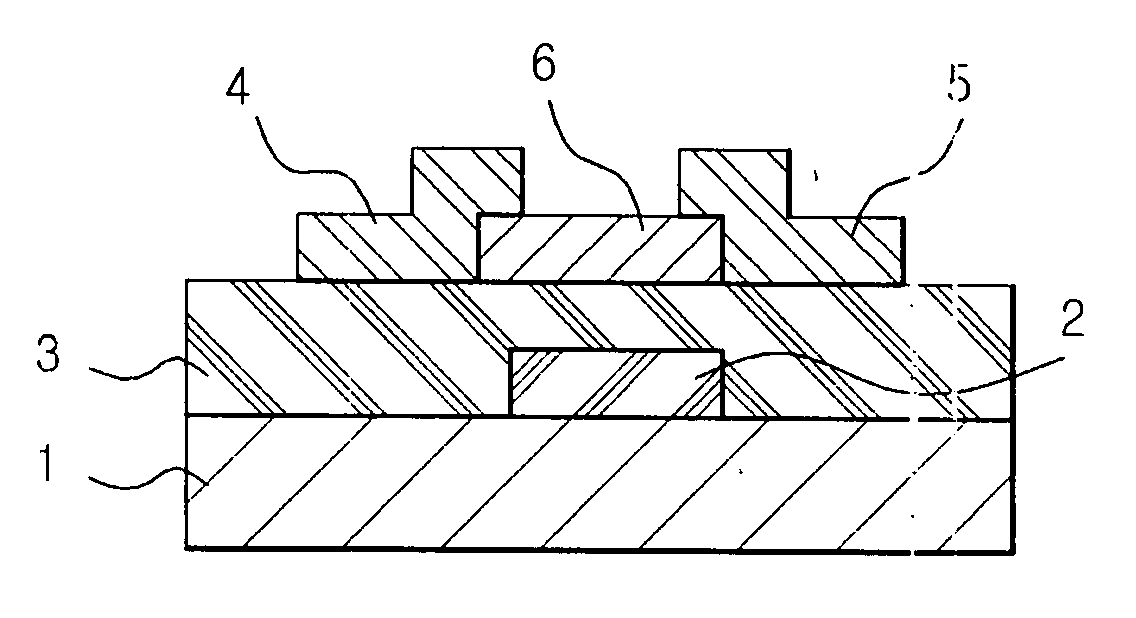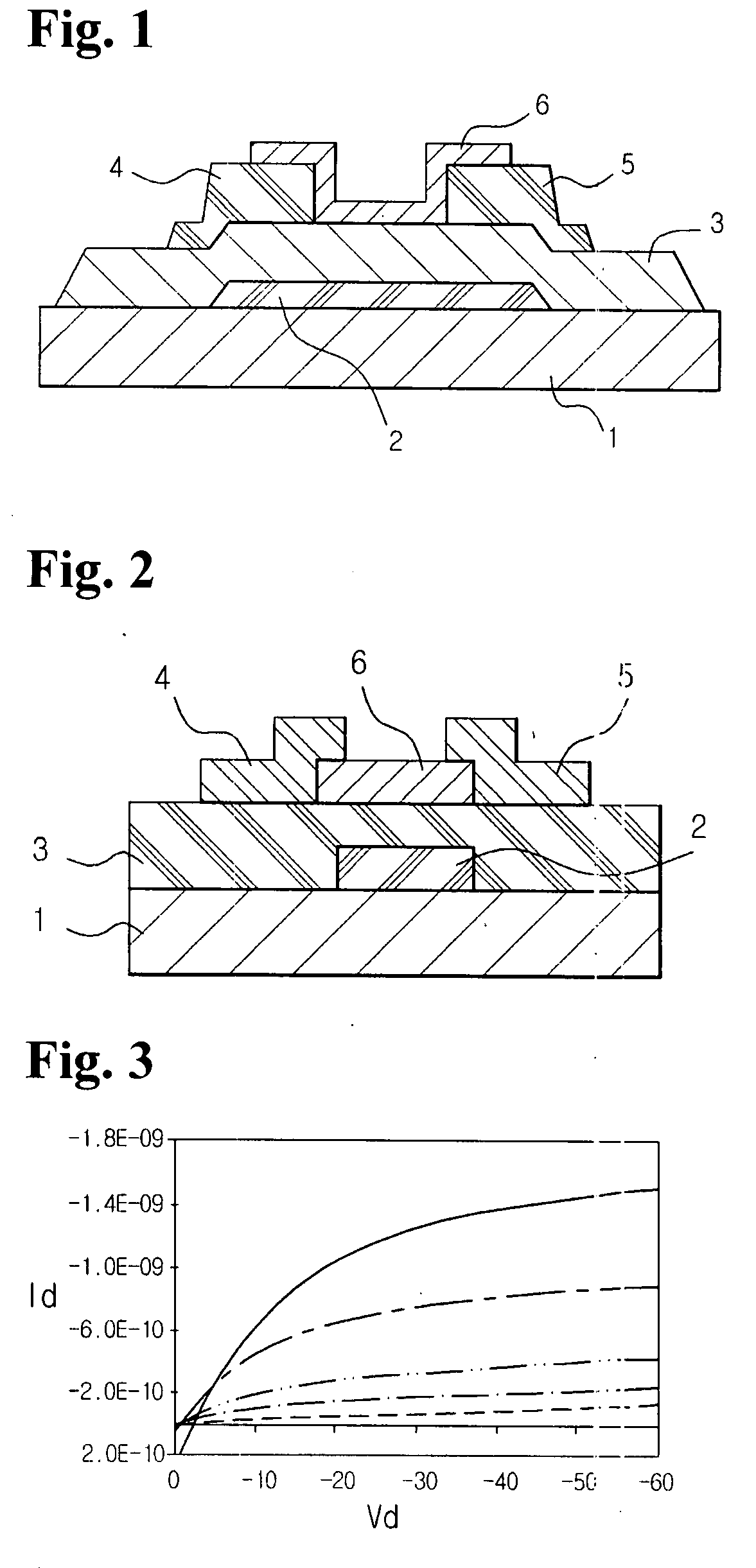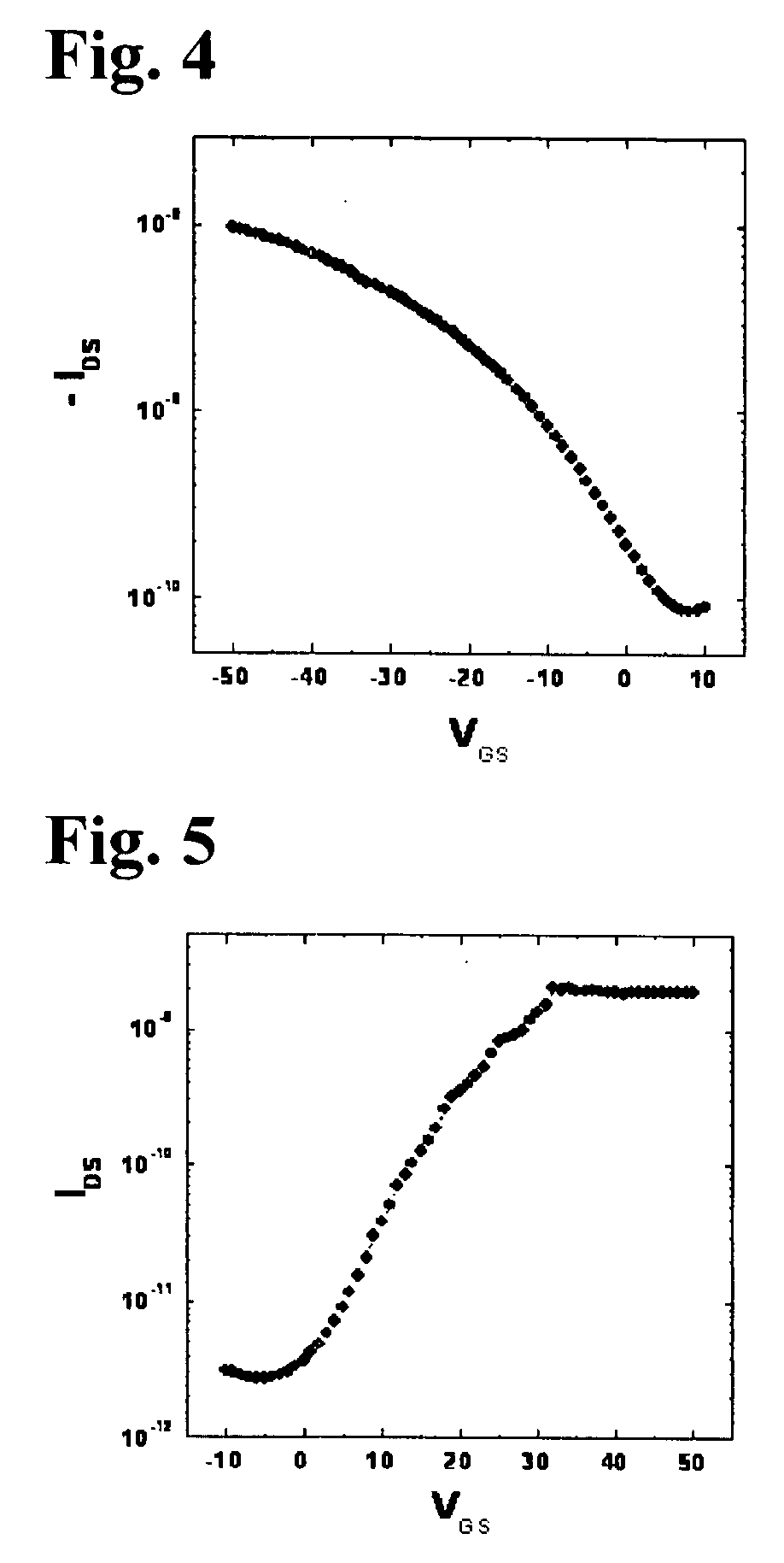Organic polymer semiconductor, method of preparing the same, and ambipolar organic thin film transistor using the same
a technology of organic thin film transistor and organic polymer semiconductor, which is applied in the direction of luminescent compositions, chemistry apparatus and processes, thermoelectric devices, etc., can solve the problems of undetectable decrease of the on/off ratio and inability to serve in electronic devices, so as to reduce the cut-off leakage current and increase the charge mobility
- Summary
- Abstract
- Description
- Claims
- Application Information
AI Technical Summary
Benefits of technology
Problems solved by technology
Method used
Image
Examples
example 1-a
PREPARATIVE EXAMPLE 1-a
Synthesis of 5,8-Dibromoquinoxaline Derivative (a)
[0078]To about 60 ml of a solution of 3,6-dibromo-o-phenylenediamine (about 4.0 g, about 15.0 mmol) in butanol, glacial acetic acid was added in an amount of about 2˜about 3 droplets, and then the solution was stirred at about 120° C. for about 5 hours. The resulting reaction solution was cooled to about 0° C. and filtered, and the separated solid was washed two times with hot ethanol and then dried. (Yield: about 9.6 mmol, about 64%.)
[0079]1H-NMR (300 MHz, CDCl3) δ(ppm) 3.85 (s, 6H, Phenyl-O—CH3), 6.89 (d, 4H, Phenyl-H), 7.66 (d, 4H, Phenyl-H), 7.85 (d, 2H, Quinoxaline-H).
example 1-b
PREPARATIVE EXAMPLE 1-b
Synthesis of 5,8-Dibromoquinoxaline Derivative (b)
[0080]Into a recovery flask, a 5,8-dibromoquinoxaline derivative (a) (about 4.55 g, about 9.1 mmol) and about 30 equivalents of pyridine hydrochloride (Py-HCl, about 40 g) were added, stirred at about 200° C. for about 8 hours, and then cooled to about room temperature. About 80 ml of an aqueous hydrochloric acid (about 2.5%) was added thereto, and the reaction solution was stirred well and then separated with ether. The organic layer was treated with dilute aqueous hydrochloric acid, aqueous sodium hydroxide, and aqueous hydrochloric acid, in that order, and then further separated with ether. The resultant organic layer was washed with water, and then dried using a drying agent, thereby obtaining a yellow solid. (Yield: about 8.7 mmol, about 96%.)
example 1-c
PREPARATIVE EXAMPLE 1-c
Synthesis of 5,8-Dibromoquinoxalne Derivative (c)
[0081]A solution of 5,8-dibromoquinoxalne derivative (b) (about 6.0 g, about 12.7 mmol) and aqueous potassium hydroxide (KOH, about 0.5 M, about 32 mmol) in ethanol was stirred at about room temperature for about 1 hour and then added with n-bromohexane (about 5.25 g, about 32 mmol). The reaction solution was allowed to react at about 70° C. for about 24 hours, cooled to about −20° C., and then filtered. Subsequently, column purification (development solvent: chloroform, filler: silica gel SiO2) was performed, thus obtaining a yellow solid. (Yield: about 2.2 mmol, about 51%.)
[0082]1H-NMR (300 MHz, CDCl3) δ(ppm) 0.92 (6H, CH3), 1.32˜1.50 (m, 24H, —(CH2)n—), 1.80 (m, 4H, —CH2—), 3.99 (t, 4H, Phenyl-O—CH2—), 6.87 (d, 4H, Phenyl-H), 7.64 (d, 4H, Phenyl-H), 7.85 (d, 2H, Quinoxaline-H).
PUM
| Property | Measurement | Unit |
|---|---|---|
| semiconductor | aaaaa | aaaaa |
| ferroelectric | aaaaa | aaaaa |
| p-type semiconductor properties | aaaaa | aaaaa |
Abstract
Description
Claims
Application Information
 Login to View More
Login to View More - R&D
- Intellectual Property
- Life Sciences
- Materials
- Tech Scout
- Unparalleled Data Quality
- Higher Quality Content
- 60% Fewer Hallucinations
Browse by: Latest US Patents, China's latest patents, Technical Efficacy Thesaurus, Application Domain, Technology Topic, Popular Technical Reports.
© 2025 PatSnap. All rights reserved.Legal|Privacy policy|Modern Slavery Act Transparency Statement|Sitemap|About US| Contact US: help@patsnap.com



